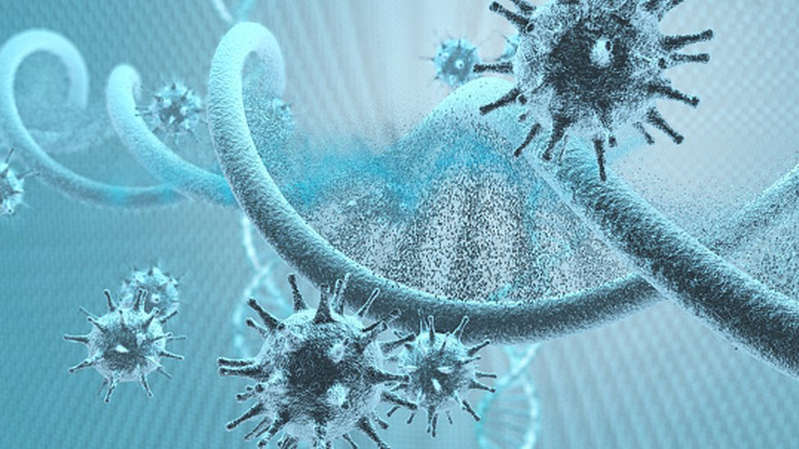Among the scientific news of the week:
- War of encodings in the world of viruses and bacteria
- Division of labor in the Neorlith era
- Aspirin against dirty air
Genetic engineering as a weapon in bacteriological warfare

A non-cellular infectious agent changes its code. Agree, it sounds like a line from a science fiction spy novel. And in fact it is so, because we are talking about viruses (they are agents) and microbes, which are waging a protracted war to infect and destroy each other. And in this war, not being bound by any conventions, they use the most sophisticated weapons, even genetic ones.
At least this is the conclusion reached by biologists Michael Groom and Farren Isaacs, who discovered an army of bacteriophages (viruses that eat bacteria) with non-standard DNA, which scientists called the Z-genome.
“Genomic DNA consists of four basic nucleotides (nitrogenous bases of adenine (A), thymine (T) cytosine (C) and guanine (G), which together make up ATCG – the so-called alphabet of the genetic code, and all forms of life on Earth have this built-in alphabet, – explain the researchers. – However, in 1977, in the DNA of the cyanophage virus S-2L, adenine (A) was replaced by 2-aminoadenine (Z), which changed the genetic alphabet itself – ZTCG. “
This modification, apparently, made the virus more resistant, since it became more difficult for bacteria to break its genome (with the help of a chemical weapon, by the way, nucleases).
Then the scientists were amazed at the resourcefulness of the virus, but since no other bacteriophages with the Z-genome could be found, and the only one available in captivity refused to breed, they decided to forget about it as a rare curiosity.
And now three scientific groups from China and France have taken up the Z-genome at once, which not only discovered a whole group of viruses with a modified genome, but also identified two main proteins that make up the basis of this genome.
But the most interesting thing, according to the head of the research team at Tianjin University, Yan Zhou, is that the Z-base was found in one of the carbon meteorites and could well have given rise to life on Earth.
- Useful Eaters. What will happen to us if all viruses disappear?
- Scientists: more than half of your cells are not human
Difficult female share of the Neolithic era

It would seem that history textbooks clearly explained to us how, from time immemorial, the division of labor – and roles – between men and women happened: while some ran after the game and fought off predators and evil neighbors, others looked after children, sewed clothes from skins and supported fire in the hearth.
This is evidenced by objects found in burials of the Neolithic times in vast territories, from modern Slovakia to eastern France.
Men were usually buried with stone tools for woodworking or weapons for hunting or more sinister purposes, and women with scrapers and other utensils for processing hides and skins.
But can such a distribution of responsibilities be considered gender inequality? And how did certain occupations become associated with men or women for many centuries to come?
Researchers led by Alba Musclance analyzed for the first time more than 400 stone tools found in early Neolithic burials in Central Europe in order to find out how these objects were used during the life of their owners. For this, the physical characteristics of these items were studied in detail, including the nature of their wear.
As a result, scientists came to the conclusion that people were not necessarily buried with the tools that they owned or used: these objects could be chosen in order to emphasize the typical function that this person (or representatives of this gender) performed in a particular society. …
“Our modern patriarchal notions of work force us to apply our experience to prehistoric times,” says Musclance. “For example, when we talk about housework and childcare, we automatically associate it with women's activities and count the people who do them. , and this work itself seems to be second-rate, but we know nothing about the significance of such work in the coordinates of the Neolithic or Paleolithic value system. “
Meanwhile, according to the scientist, the Neolithic communities could well value housework and other purely female occupations much higher than is customary today.
“It is important for me not only to affirm the idea that women were also present there – which some historians completely forget – but also to understand what role they played in these socioeconomic processes, how this affected their quality of life and what new opportunities it provided them “, says the researcher.
- Is the Stonehenge mystery nearing its end?
- Reverse discrimination: men in Sweden are not hired for “female” jobs
A new facet of old aspirin

In a routine study of the effects of fine particulate matter and carbon in the atmosphere on human health, conducted with a select group (cohort) of older men in the suburbs of Boston, the researchers (their work published in Nature Aging) came to two conclusions: rather predictable and very unexpected …
Firstly, it turned out that a polluted atmosphere reduces the cognitive functions of a person, and secondly, that ordinary aspirin can interfere with this process.
The authors of the study were unable to prove a direct link between aspirin and its effects on the brain, but they did find with certainty that participants in the cohort who took nonsteroidal anti-inflammatory drugs (NSAIDs) performed significantly better on tests for memory, concentration and ability to follow instructions.
As a result, they came to the conclusion that short-term exposure to a polluted atmosphere can lead to short-term changes in cognitive functions, but this process can be reversed by using NSAIDs, read – aspirin.
Scientists believe that the whole point may be in how exactly aspirin reduces inflammation in the brain (and such inflammation with poor air quality can become chronic).
“Our findings do not yet support the need for all older adults to take anti-inflammatory drugs because we must not forget about the side effects of these drugs,” says co-author Andrea Baccarelli.
However, she said, more research is needed with more volunteers to find out exactly how impurities in the atmosphere harm the brain and what aspirin does to the brain to neutralize this harmful effect.
- An aspirin tablet a day for prevention? Scientists advise against
- British doctors: with a microstroke you need to drink aspirin
- Our brain and the whole truth about the “pill for the mind”

